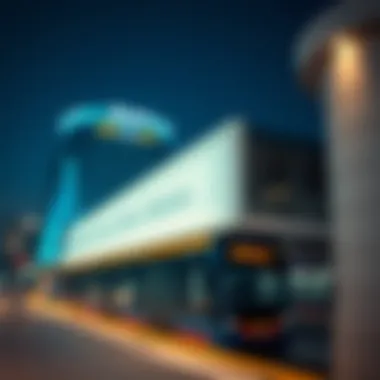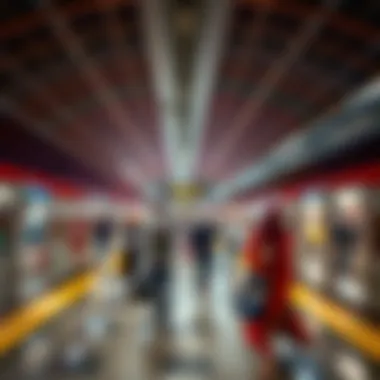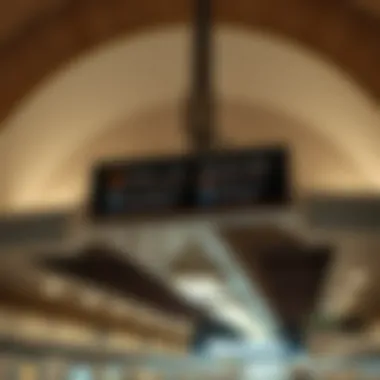Discovering Dubai's Metro Stations and Their Impact


Intro
Dubai, a city known for its soaring skyscrapers and luxurious lifestyle, has transformed significantly over the years. One key player in this evolution is the Dubai Metro system. This underground and elevated rail network not only connects various parts of the city but also serves as a catalyst for urban expansion and real estate development.
The importance of the metro system goes beyond mere transportation. It influences real estate prices, enhances neighborhood accessibility, and shapes the way residents live and interact with their environment. Whether one is a savvy investor eyeing property in the vicinity of major metro stops or a buyer looking for vibrant community living, understanding the nuances of the Dubai Metro can make a significant difference.
In the following sections, we will explore the market trends surrounding the metro stations—analyzing current conditions and making predictions for the future. We will also delve into investment strategies that can help navigate the shifting landscape of Dubai’s real estate market. Through this article, our goal is to offer a comprehensive guide that empowers investors, agents, and homebuyers to make informed decisions based on the connectivity provided by the metro system.
Prolusion to the Dubai Metro
The Dubai Metro system stands as a testament to the city’s innovative approach to urban transport. As we dive into its framework, it's essential to recognize not just the physical infrastructure, but also the underlying significance it holds for the community, economy, and real estate landscape of this dynamic emirate. By serving as a major conduit for commuters, tourists, and residents alike, the metro enhances connectivity while reducing congestion on roadways.
Currently, the metro is among the most modern rapid transit systems globally, reflecting both Dubai's aspirations and its commitment to sustainability. With its extensive network, the metro plays a crucial role in shaping various aspects of urban living—from shaping neighborhoods to boosting local property values.
Historical Context
The seeds for the Dubai Metro were sown in the early 2000s, spurred by the rapid population growth and an increasing density of traffic. The initial planning stages began in 2000, led by the Dubai Roads and Transport Authority (RTA). Challenges abounded, from integrating the system smoothly with existing infrastructure to ensuring it met the needs of a diverse user base. Yet, by 2009, the first line of the metro—the Red Line—commenced operations, marking a pivotal moment in Dubai’s transportation history.
In the years that followed, the network expanded to include an array of lines and stations, adapting to the needs of an ever-evolving urban landscape. Today, as riders glide through the expansive network, they traverse not just the physical spaces of the urban area but also the historical evolution of Dubai itself.
Current Operational Status
Fast forward to the present, and the Dubai Metro is operating smoothly with two primary lines: the Red Line and the Green Line, encompassing over 75 kilometers of track and multiple stations that cater to the city's bustling population. The Red Line runs from Rashidiya to UAE Exchange, while the Green Line connects Xinib to Dubai Creek.
Ridership has steadily increased, reflecting the efficacy and convenience of this mode of transport. More than half a million passengers daily rely on the metro for their daily commute, emphasizing its role as a critical transit alternative. Moreover, with ongoing technological advancements, such as contactless payment systems and real-time updates, the operational capacity is expected only to improve.
In essence, the Dubai Metro is not just a mode of transport; it is a lifeline for the city, fostering economic growth and redefining urban mobility. As we explore the subsequent sections, it becomes increasingly apparent how deeply intertwined the metro system is with Dubai’s broader growth narrative.
Overview of Metro Lines and Stations
The metro system in Dubai is like the veins of the city, pumping life and connectivity through its urban landscape. This section aims to give readers a hearty understanding of the metro lines and stations, specifically focusing on the dual-line system that facilitates seamless travel across the vibrant cityscape.
Importance of Metro Lines
A well-functioning public transportation system is critical for any urban environment, and Dubai's metro is no exception. With two primary lines—the Red Line and the Green Line—each offering distinct routes and services, commuting becomes less of a chore and more of a fluid experience.
- **Benefits of Metro Lines
- Efficient Time Management:** The metro drastically reduces travel time when compared to road transport, especially during peak hours.
- Environmental Benefits:** Using public transport aids in reducing the carbon footprint, aligning with Dubai’s sustainability goals.
- Economic Growth:** By linking key economic zones and tourist attractions, the metro stimulates local businesses and increases overall economic output.


Key Features of the Metro Stations
The stations along each line boast unique characteristics that cater to the diverse needs of the city’s inhabitants. They act not only as transport hubs but also as gateways to various neighborhoods, contributing significantly to urban development and real estate dynamics.
- Unique Features: Many stations offer integrated services, including shops and eateries, making the commute a more fulfilling experience.
In summary, understanding the metro lines and stations provides key insights into how Dubai’s public transport system enhances mobility and influences the real estate market. With stations positioned strategically across the city, the metro system exemplifies urban planning done right.
Significant Metro Stations: A Closer Look
The Dubai Metro system boasts several significant stations that act as pivotal arteries within the urban landscape. These stations are not just transit points but are also intertwined with the city's socio-economic fabric. By delving into the specifics of these stations, we can uncover the benefits they offer, not only to commuters but also to real estate investors, city planners, and the general public.
Union Station
Role in the Metro Network
Union Station, as one might guess, is a linchpin of the Dubai Metro network. It serves as a crucial interchange between the Red and Green lines. This interconnectivity enhances commuter experience, allowing for seamless travel across the city. The station is often bustling with activity, making it a popular hub for both daily commuters and tourists. Its strategic location in the heart of the city, near major commercial and cultural landmarks, makes it a prime choice for those seeking convenience and accessibility.
A notable characteristic of Union Station is its efficient design, which helps facilitate smooth passenger flow. This, in turn, positively affects the overall network's efficiency, making it a central stop for anyone traveling through Dubai. The unique aspect of having a major interchange in a city that is continually expanding its metro offerings allows for ongoing flexibility in route planning and commuter options.
Surrounding Landmarks
Union Station is not only a transit point but also stands close to significant landmarks such as the Deira City Centre Mall and the Dubai Creek area. These sites contribute to the station's allure, drawing visitors who wish to experience the city's vibrant culture or indulge in shopping sprees. The proximity of these attractions enhances the station's utility, providing commuters not just a way to get from point A to point B, but also a gateway to a variety of activities.
However, the high foot traffic can sometimes lead to overcrowding, especially during peak hours. This can deter some users and serve as a drawback for certain potential investors in nearby areas. Nevertheless, the blend of connectivity and surrounding amenities marks Union Station as a notable contributor to Dubai's urban landscape.
Burj Khalifa/Dubai Mall Station
Integration with Tourism
The Burj Khalifa/Dubai Mall Station is arguably one of the most visited stops on the entire metro line, thanks largely to its proximity to the world's tallest building and the expansive Dubai Mall. This integration fosters an unparalleled influx of tourists, serving to elevate the overall appeal of the metro system as a tourism facilitator. What’s unique about this station is that it directly links high-caliber attractions to the public transport network, making it easier for visitors to access these iconic sites.
As the entry point for many tourists, the station plays a vital role in enhancing their experience by providing easy access to the city's most glamorous shopping, dining, and entertainment hubs. This not only underscores the importance of public transport in modern urban environments but showcases a successful model of integrating tourism within an everyday transit system.
Impact on Property Values
The vicinity of Burj Khalifa/Dubai Mall Station has notable implications for property values in the surrounding areas. Studies indicate that properties located near this station command higher prices due to their accessibility to major attractions. Investors keen on capitalizing on this trend may find themselves drawn to the residential and commercial developments near this stop.
However, the higher property prices can also be a double-edged sword. While owners can enjoy growth in value, potential buyers may hesitate due to elevated costs. Thus, this station not only boosts tourism but also reshapes the local real estate dynamic.


Dubai Marina Station
Residential and Commercial Viability
Dubai Marina Station is another key player in the metro system, particularly valued for its contribution to the area's residential and commercial viability. The Marina is well-known for its luxurious lifestyle offerings and contemporary architecture, which naturally attracts affluent residents and businesses alike. This station effectively connects users to the glitz of the Marina area, with many residents relying on it for daily commutes.
One key aspect of this station is the surrounding high-rise developments, which often feature retail spaces that cater to both locals and tourists. The quick access via the metro to other urban areas enhances its appeal. On the other hand, the saturation of the residential market can lead to variances in rental prices, creating a need for strategic investment decisions among potential buyers.
Neighborhood Dynamics
The dynamics of the Dubai Marina neighborhood are heavily influenced by the presence of the metro station. It not only fosters a sense of community but also drives a cosmopolitan vibe that appeals to a diverse range of residents. Having a metro station in this affluent area opens doors to various demographics, making it an attractive option for both businesses and investors.
However, one must consider the potential fluctuations in community sentiment, as an influx of residents mixed with tourists can sometimes strain local resources and amenities. So, while the station secures a lively atmosphere, it also necessitates careful management of neighborhood resources.
Business Bay Station
Commercial Growth Drivers
Business Bay Station serves as a critical component for the commercial landscape of Dubai. This area is designed to be a commercial hub, and the existence of the metro station propels this vision forward. The station greatly contributes to the accessibility of business opportunities and is strategically located amidst numerous high-rise office buildings and commercial developments.
A unique feature of this station is that it leads directly into Dubai's economic heart, fortifying its role as a commercial growth driver. This access facilitates easy movement between major businesses and clients, fostering networking opportunities. Investors often see the potential here as commercial entities assemble around the transit hub, spurring growth and innovation within the area.
Investment Opportunities
The potential for investment around Business Bay Station is significant. The rise in commercial activities encourages a demand for both office spaces and residential property catering to the professionals who work in the area. The location provides a clear advantage for those looking to capitalize on the burgeoning market.
Yet, prospective investors should weigh their options carefully. With high demand comes competition, and real estate prices can reflect this trend. Understanding market conditions is essential for making informed investment decisions, thus presenting both an opportunity and a challenge.
By exploring the significant metro stations across Dubai, we can grasp their critical roles not only in the transportation framework but also in shaping the urban landscape and influencing the dynamics of property markets and community life.
Impact of Metro Stations on Real Estate Market
The intersection of transportation networks and property values has become a focal point in urban planning and real estate investment. In Dubai, the metro stations serve as pivotal anchors, influencing the dynamics of the housing market. As the city continues to modernize, understanding how these transport nodes affect real estate can provide valuable insights for investors, buyers, and agents alike.
One significant aspect is the correlation between accessibility and property prices. When properties are located within walking distance of metro stations, they often command higher prices. This is not merely a coincidence; proximity to transit systems enhances the attractiveness of residential areas. A study demonstrated that properties near metro stations have seen price appreciation of up to 20% compared to those further away. The convenience of rapid transit appeals to both buyers and tenants, leading them to prefer locations that minimize their commuting time. Hence, real estate professionals should pay close attention to developments around the metro stations when assessing property values.
Additionally, the consumer preferences in metro areas shift towards accessibility and convenience. Today's buyers and renters often prioritize locations that offer not just housing but a lifestyle that includes efficient transportation options. Many young professionals and families are looking for areas where education, employment, and leisure activities are easily accessible via a metro line. This trend is particularly pronounced in vibrant neighborhoods like Dubai Marina or Business Bay, where real estate markets thrive due to their close ties to metro stations.
As a result, the surrounding properties of significant stops often see sustained demand, thereby impacting long-term investment viability in these areas.


Understanding these two elements – the direct link between accessibility and property prices, and shifting consumer preferences – is crucial for anyone looking to make informed decisions about investing in Dubai's real estate market. The metro stations aren't merely stops along a route; they represent gateways to opportunities in one of the world’s fastest-growing cities.
Future Developments and Extensions
The Dubai Metro, a cornerstone of the city’s transit landscape, has always been in a state of evolution. Looking to the horizon, future developments and expansions are not just promises but pivotal steps toward a more connected and dynamic urban environment. As city planners and developers set their sights on extending the metro network, the relevance of these projects looms large, impacting not only commuting patterns but also urban growth and real estate dynamics.
Upcoming Metro Lines
As demand for efficient public transit continues to rise, the introduction of new metro lines is on the table. Plans are already in motion for several key expansions that could reshape how residents travel throughout Dubai. For instance, a line extending to Dubai World Central is proposed. This expansion not only offers access to the new airport but potentially opens the gateway to areas previously underserved by public transport.
Expanding the network requires critical financial investment and strategic planning. Stakeholders anticipate that these new metro lines will connect bustling business districts, residential areas, and cultural hubs, further integrating them into the urban fabric.
Moreover, linking these lines will encourage more people to adopt the metro as their primary mode of transport. Here are some expected benefits of the new lines:
- Enhanced Accessibility: Residents will have easier routes to work, schools, and entertainment.
- Reduced Traffic Congestion: With more people choosing public transport, vehicular traffic could diminish.
- Economic Growth: New metro stations often stimulate economic activity in previously inactive areas.
Adaptive Changes in Existing Stations
While new lines capture attention, it’s equally essential to consider the adaptive changes in existing metro stations. These changes often reflect the ongoing need to accommodate shifting demographics, technology, and user expectations.
For example, the introduction of smart ticketing systems at current stations is in the works. This not only modernizes the travel experience but also aligns with Dubai's vision of being a smart city. Aside from technology upgrades, station aesthetics are also evolving. With ongoing refurbishments, stations are becoming more appealing, featuring art displays, spacious waiting areas, and improved accessibility for differently-abled passengers.
Such adaptive changes benefit various stakeholders:
- Increased User Satisfaction: Enhanced facilities and aesthetics can lead to higher customer satisfaction.
- Attraction of New Riders: A more inviting environment might welcome those who have been hesitant to use public transport.
- Boost to Local Businesses: Upgraded stations can attract more foot traffic, benefiting nearby businesses.
"The evolution of existing stations alongside new line extensions represents a holistic approach to urban transport, acknowledging the past while building for the future."
Closure
The discussion surrounding the Dubai Metro system closes with a reflection on its significance in the urban landscape, particularly regarding accessibility and investment opportunities. Overall, this article sheds light on the metro's critical role in shaping not only the city’s transportation framework but also its very fabric of socio-economic interactions.
Summary of Key Insights
The insights gathered throughout the examination of the Dubai Metro reveal several key points.
- Essential Connectivity: The metro stations serve as lifelines connecting different districts, boosting trade, tourism, and daily commuting. This enhanced connectivity influences the desirability of nearby properties.
- Impact on Property Values: Data indicates a direct correlation between proximity to metro stations and property prices. Investors keen on maximizing returns should consider locations near major lines like the Red and Green Lines.
- Urban Development Catalyst: Stations often spur developments, be it commercial or residential, making these areas increasingly attractive. As noted, sectors such as Business Bay and Dubai Marina have flourished due to strategic metro access.
In essence, the relationship between the metro and real estate is not just coincidental; it is a vital piece of Dubai's evolving narrative. This connection enhances the urban experience and solidifies the investor’s perspective towards a thoughtful approach in real estate pursuits.
Final Thoughts on Investment Potential
Examining the investment potential tied to the Dubai Metro provides an intriguing lens for real estate buyers and agents. As seen, the metro doesn't just transport people; it drives value. With numerous developments on the horizon, potential investors must keep an eye on properties near station expansions.
- Market Trends: The engagement of international investors has heightened the competitive dynamics of real estate in metro-adjacent areas. Growth trends suggest that as more people flock to the metro linked locales, demand for properties is likely to spike.
- Long-term Viability: Areas with metro lines continue to see sustainable interest. Those contemplating buying property here should analyze access to public transport as a long-term investment strategy.







